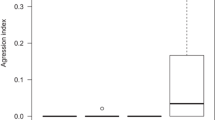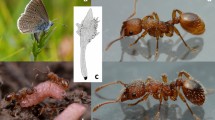Abstract
Phengaris (=Maculinea) arion is an endangered social parasite of Myrmica ants, and for a very long time was considered as specific to Myrmica sabuleti. Previous studies carried out in Poland suggested some discrepancies within this assumption, and therefore a much more intensive survey was undertaken. The host ant use of P. arion was studied at five sites in different types of biotopes in Poland, i.e. xerothermal grasslands where Thymus pulegioides was used as a larval food plant by the butterfly, and more or less sandy biotopes with Thymus serpyllum. Altogether nine Myrmica species were recorded, and considerable variation in species composition and density of nests was recorded. At four localities M. sabuleti proved to be the most common ant. A total of 529 Myrmica nests were examined, and only 20 of them contained larvae and pupae of P. arion. Host ants belonged to five different species, i.e. M. sabuleti, Myrmica scabrinodis, Myrmica schencki, Myrmica lobicornis and Myrmica hellenica. Only at one site (NE Poland) was a significant heterogeneity in parasitation rates among Myrmica species detected. M. lobicornis was the most often infested ant there, which may suggest local specialisation of the butterfly. Overall low parasitism rates may explain the vulnerability of P. arion in Central Europe but further studies are also necessary.



Similar content being viewed by others
References
Als TD, Vila R, Kandul NP, Nash DR, Yen SH, Hsu YF, Mignault AA, Boomsma JJ, Pierce NE (2004) The evolution of alternative parasitic life histories in large blue butterflies. Nature 432:386–390
Barbero F, Thomas JA, Bonelli S, Balletto E, Schönrogge K (2009) Queen ants make distinctive sounds that are mimicked by a butterfly social parasite. Science 323:782–785
Czechowski W, Radchenko A, Czechowska W (2002) The ants (Hymenoptera, Formicidae) of Poland. Museum and Institute of Zoology PAS, Warsaw
Dennis RLH, Shreeve TG, Van Dyck H (2006) Habitats and resources: the need for a resource-based definition to conserve butterflies. Biodiv Conserv 15:1943–1966
Elmes GW, Thomas JA, Wardlaw JC, Hochberg ME, Clarke RT, Simcox DJ (1998) The ecology of Myrmica ants in relation to the conservation of Maculinea butterflies. J Insect Conserv 2:67–78
Elmes GW, Wardlaw JC, Schönrogge K, Thomas JA, Clarke RT (2004) Food stress causes differential survival of socially parasitic caterpillars of Maculinea rebeli integrated in colonies of host and non-host Myrmica ant species. Entomol Exp Appl 110:53–63
Fric Z, Wahlberg N, Pech P, Zrzavý J (2007) Phylogeny and classification of the Phengaris-Maculinea clade (Lepidoptera: Lycaenidae): total evidence and phylogenetic species concepts. System Entomol 32:558–567
Nash DR, Als TD, Maile R, Jones GR, Boomsma JJ (2008) A mosaic of chemical coevolution in a large blue butterfly. Science 319:88–90
Pauler-Fürste R, Kaule G, Settele J (1996) Aspects of the population vulnerability of the large blue butterfly, Glaucopsyche (Maculinea) arion, in south-west Germany. In: Settele J, Margules C, Poschlod P, Henle K (eds) Species survival in fragmented landscapes. Kluwer, Dordrecht, pp 275–281
Pech P, Fric Z, Konvicka M (2007) Species-specificity of the Phengaris (Maculinea)–Myrmica host system: Fact or myth? (Lepidoptera: Lycaenidae; Hymenoptera: Formicidae). Sociobiology 50:983–1004
Pecsenye K, Bereczki J, Tihanyi B, Toth A, Peregovits L, Varga Z (2007) Genetic differentiation among the Maculinea species (Lepidoptera: Lycaenidae) in eastern Central Europe. Biol J Linn Soc 91:11–21
Putyatina TS (2007) The choice of foraging strategy as a mechanism for the coexistence of Myrmica species (Hymenoptera, Formicidae) in a multispecific ant association. Entomol Rev 87:650–657
Schönrogge K, Wardlaw JC, Peters AJ, Everett S, Thomas JA, Elmes GW (2004) Changes in chemical signature and host specificity from larval retrieval to full social integration in the myrmecophilous butterfly. J Chem Ecol 30:91–107
Settele J, Kühn E, Thomas JA (2005) Studies on the ecology and conservation of butterflies in Europe: species ecology along a European gradient: Maculinea butterflies as a model, vol 2. Pensoft, Sofia, Moscow
Sielezniew M, Dziekańska I (2009) Butterfly-ant relationships: host ant specificity of Phengaris ‘rebeli’ Hirschke (Lepidoptera: Lycaenidae) in Pieniny Mts (southern Poland). Pol J Ecol 57:403–409
Sielezniew M, Stankiewicz AM (2007) Differences in the development of the closely related myrmecophilous butterflies Maculinea alcon and M. rebeli (Lepidoptera: Lycaenidae). Eur J Entomol 104:433–444
Sielezniew M, Stankiewicz AM (2008) Myrmica sabuleti (Hymenoptera: Formicidae) not necessary for the survival of the population of Phengaris (Maculinea) arion (Lepidoptera: Lycaenidae) in eastern Poland: lower host-ant specificity or evidence for geographical variation of an endangered social parasite? Eur J Entomol 105:637–641
Sielezniew M, Stankiewicz A, Bystrowski C (2003) First observation of one Maculinea arion pupa in a Myrmica lobicornis nest in Poland. Nota lep 25:249–250
Sielezniew M, Buszko J, Stankiewicz AM (2005) Maculinea arion in Poland: distribution, ecology and prospects of conservation. In: Settele J, Kühn E, Thomas JA (eds) Studies on the ecology and conservation of butterflies in Europe. Species ecology along a European gradient: Maculinea butterflies as a model, vol 2. Pensoft, Sofia, Moscow, pp 231–233
Stankiewicz A, Sielezniew M (2002) Host specificity of Maculinea teleius Bgstr. and M. nausithous Bgstr. (Lepidoptera: Lycaenidae) the new insight. Ann Zool 53:403–409
Stankiewicz AM, Sielezniew M, Švitra G (2005) Myrmica schencki rears Maculinea rebeli in Lithuania: new evidence for geographical variation of host-ant specificity of an endangered butterfly. Myrmecol Nachr 7:51–54
Tartally A, Varga Z (2008) Host ant use of Maculinea teleius in the Carpathian Basin (Lepidoptera: Lycaenidae). Acta Zool Acad Sci Hung 54:257–268
Tartally A, Nash DR, Lengyel S, Varga Z (2008) Patterns of host ant use by sympatric populations of Maculinea alcon and M. ‘rebeli’ in the Carpathian Basin. Insect Soc 55:370–381
Thomas JA (1995) The ecology and conservation of Maculinea arion and other European species of large blue butterfly. In: Pullin AS (ed) Ecology and conservation of butterflies. Chapman and Hall, London, pp 180–197
Thomas JA (2002) Larval niche selection and evening exposure enhance adoption of a predacious social parasite, Maculinea arion (large blue butterfly), by Myrmica. Oecologia 132:531–537
Thomas JA, Elmes GW (1998) Higher productivity at the cost of increased host-specificity when Maculinea butterfly larvae exploit ant colonies through trophallaxis rather than by predation. Ecol Entomol 23:457–464
Thomas JA, Settele J (2004) Butterfly mimics of ants. Nature 432:283–284
Thomas JA, Wardlaw JC (1990) The effect of queen ants on the survival of Maculinea arion larvae in Myrmica ant nest. Oecologia 85:87–91
Thomas JA, Elmes GW, Wardlaw JC, Woyciechowski M (1989) Host specificity among Maculinea butterflies in Myrmica ant nests. Oecologia 79:425–457
Thomas JA, Elmes GW, Schonrogge K, Simcox DJ, Settele J (2005) Primary hosts, secondary hosts and ‘non-hosts’: common confusion in the interpretation of host specificity in Maculinea butterflies and other social parasites of ants. In: Settele J, Kühn E, Thomas JA (eds) Studies on the ecology and conservation of butterflies in Europe. Species ecology along a European gradient:Maculinea butterflies as a model, vol 2. Pensoft, Sofia, Moscow, pp 99–104
Thomas JA, Simcox DJ, Clarke RT (2009) Successful conservation of a threatened Maculinea butterfly. Science 325:80–83
Van Swaay CAM, Warren MS (1999) Red data book of European butterflies (Rhopalocera). Nature and Environment, vol 99. Council of Europe, Strasbourg
Witek M, Sliwinska E, Skórka P, Nowicki P, Wantuch M, Vrabec V, Settele J, Woyciechowski M (2008) Host ant specificity of large blue butterflies Phengaris (Maculinea) (Lepidoptera: Lycaenidae) inhabiting humid grasslands in east-central Europe. Eur J Entomol 105:871–877
Acknowledgments
We are grateful to Paweł Borkowski, Cezary Bystrowski, Krzysztof Frąckiel, Adam Górnicki, Tadeusz Janik and Krzysztof Pałka for the precise location of study sites and/or for logistic help during field studies. Sarah Łuczaj made linguistic improvements on the draft of the manuscript. We also thank our two referees for their valuable comments on the manuscript. The Polish Minister of the Environment and the Director of the Biebrza National Park issued the relevant permissions for our studies. This work was supported by the Polish Ministry of Science and Higher Education (grant no 2 P04G 024 30).
Author information
Authors and Affiliations
Corresponding author
Rights and permissions
About this article
Cite this article
Sielezniew, M., Dziekańska, I. & Stankiewicz-Fiedurek, A.M. Multiple host-ant use by the predatory social parasite Phengaris (=Maculinea) arion (Lepidoptera, Lycaenidae). J Insect Conserv 14, 141–149 (2010). https://doi.org/10.1007/s10841-009-9235-0
Received:
Accepted:
Published:
Issue Date:
DOI: https://doi.org/10.1007/s10841-009-9235-0




